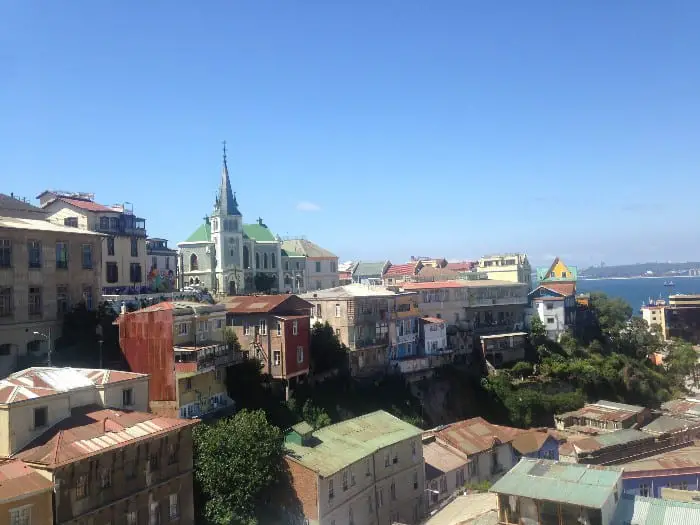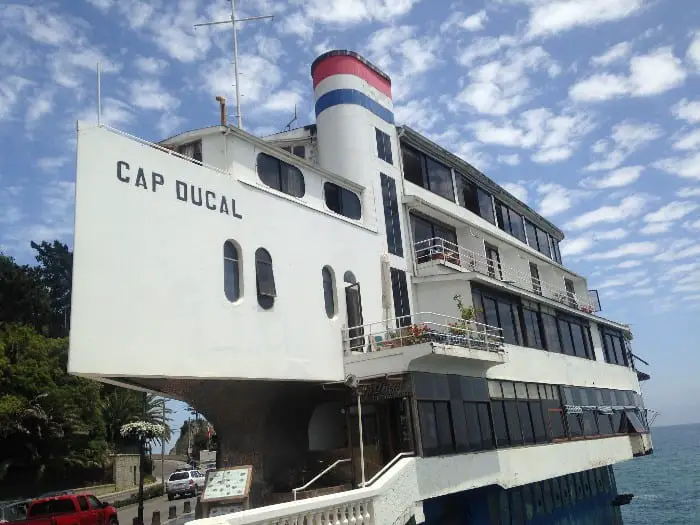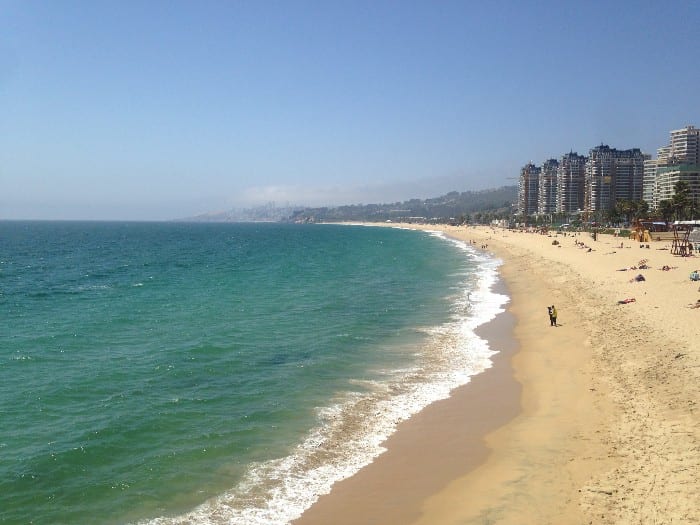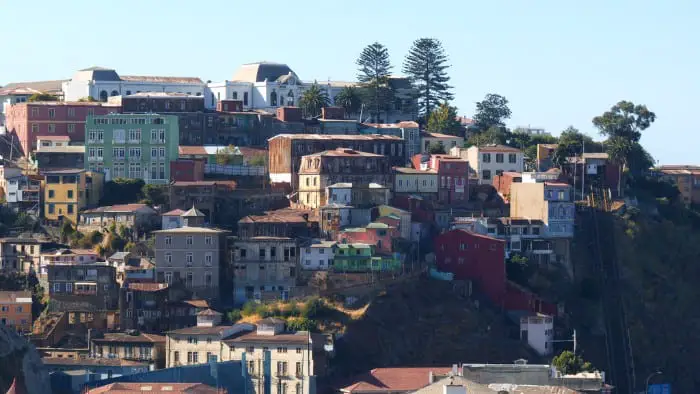Table of Contents
- 1. Why visit?
- 2. How do you get in?
- 3. How do you get around?
- 4. What is the difference between Valparaiso and Viña del Mar?
- 5. Valparaiso and Viña del Mar for Backpackers – Where is better to stay?
- 6. What is there to see and do?
- 7. Where’s good to eat, drink and party?
- 8. Any special events/festivals to look out for?
- 9. What’s the weather like?
- 10. Any cool places nearby?
1. Why visit?
Chile is a popular destination with backpackers in South America. Travellers are largely drawn to its beautiful South full of mountains, lakes, glaciers and vast national parks that are perfect for escaping the madness of the modern world and reconnecting with nature. Meanwhile in the North, the Atacama Desert, which features in our backpacking route for South America, gives off the impression you’ve left this world altogether with its lunar and martian landscapes.
However if you’re looking for a taste of urban life in Chile, the adjacent cities of Viña del Mar and Valparaiso, roughly mid-way up Chile’s vast Pacific coastline, are your best options and far more interesting than most of the other cities, arguably even including the capital Santiago.
2. How do you get in?
It is possible to take buses from other cities in Chile to Valparaiso or Viña del Mar but there are no airports and if you’re coming from far, the simplest way in is usually to fly to Santiago de Chile and connect to a bus. The bus journey from the capital to the coastal cities is roughly 120km and a bit less than two hours if the traffic isn’t too bad. Buses are incredibly regular with departures every 10-15 minutes from Pajaritos Station in Santiago and with numerous companies competing prices are low, with round-trip fares for the equivalent of around US$10 not uncommon.
Note that while some buses stop in both Valparaiso and Viña del Mar, many do not so be clear to specify your preferred destination. Viña del Mar is slightly closer to the capital by road.

3. How do you get around?
Even though Chile is enormous and these are two of the three largest cities outside of the Santiago metropolitan region, only five miles separates them. Valparaiso is visible from Viña del Mar and vice-versa and it’s very easy to get to one from the other with a metro-line connecting the two cities with regular and cheap services.
Both are small enough to explore largely on foot although Valpa is home to many steep hills so making use of the ancient lifts/funiculars (if you can find them) isn’t a bad idea although anyone in reasonable physical condition shouldn’t have too many problems. If you want to head to the beaches and sand dunes North of Viña, there are microbuses that you just hop on and pay the driver.
4. What is the difference between Valparaiso and Viña del Mar?

They are like chalk and cheese in many ways and despite being so close, they have very distinct atmospheres. Valparaiso is a historic port city, gritty in parts but with a real artistic flare and one of the world’s best examples of how to brighten up city streets with modern art and quirky designs.
Viña del Mar is its fashionable younger sibling, known for its fancy gardens and golden beaches. It is considered more of a tourist destination and certainly gets more visitors in total but Valparaiso is very popular with backpackers who are drawn to its edgier vibe.
5. Valparaiso and Viña del Mar for Backpackers – Where is better to stay?
Budget travellers will generally find Valparaiso to be cheaper with an array of hostels and prices that better those on offer in Santiago or Viña del Mar. Booking in advance isn’t totally necessary except during national holidays or over New Year. Most of the hostels are located on one of the hills directly above the sea-level city centre.
Viña tends to act more as an easy beach getaway for folks in the capital therefore you can certainly expect prices to hike up at weekends and during the summer months. The quality of accommodation is generally higher there but you might be able to bag some good deals during the week, particularly in low-season on nicer places than you’ll find five miles South in Valpa.
However if you are the type of traveller that prefers to just rock up and find a place to stay on arrival, heading to Valparaiso is the better bet. It also has more to see too so it probably makes more sense to base yourself there but you can easily spend a couple of days in both, particularly if the weather is good enough to spend time on the beach in Viña, which does have the odd hostel too.
6. What is there to see and do?

Valparaiso is full of quirks and if you’re into street art, you could easily spend a whole day here just exploring and admiring the walls and staircases that add so much character to the city. It’s a lovely place to just wander around and take everything in at your own pace but there are a few specific things that almost every visitor to Valparaiso does.
One is take a ride on one of the ‘ascensores’ which date back to the 19th century and have served as a practical way of transporting residents up the steep slopes ever since. There are also many great viewing points at the top of those points which offer stunning vistas of not only Valpa but Viña del Mar too and the beaches and cliffs further North. A visit to La Sebastiana is also high recommended, the former house of the famed poet Pablo Neruda, a key figure in the recent history of Chile.
Viña del Mar has fewer obvious points of interest but you can do a nice walk taking in La Quinta Vergara, a beautiful flower garden and Plaza del Reloj, home to a clock made of flowers, the city’s most iconic sites. Along the coast road in towards the city from Valpa, you’ll also stumble across some fabulous houses and museums, which even if you don’t go in, are worth admiring for their architecture and coastal views. Finally of course you can always just relax on the beach which forms the front of Viña’s tourism industry.
There are also free walking tours you can join in both cities (tips of $5-10 expected). It’s probably a smart idea in Valpa which has a pretty complicated layout and more history but Viña is easy enough to navigate yourself.
7. Where’s good to eat, drink and party?

If you’re hungry, nothing beats a Chorrillana, a popular dish particularly in Valparaiso consisting of an unhealthy mountain of fries topped with meat, sausage, fried onion, and fried eggs. Just about any bar or restaurant will serve it and it’s meant to be shared amongst friends so portions tend to be huge. Viña is a bit posher for want of a better word at least by South American standards and is home to plenty of excellent seafood restaurants and perhaps a classier dining experience.
The same really goes for the nightlife. Viña del Mar has some nice options whereas Valpa is rough and ready and is considered slightly more dangerous than other Chilean cities. Its nightlife though is legendary, particularly at weekends when bars and clubs stay open until 5:00am. There’s something to suit all tastes with everything from swinging salsa and reggaeton to rock and roll. There are plenty of grungy kind of options and with a large university population you shouldn’t have much problem finding a cheap night out during the week either while you can also find gay clubs and it’s the kind of city where anything seems to go.
8. Any special events/festivals to look out for?
There are two really major events each year in these parts and both take place during the summer:
The Vina del Mar Music Festival is one of the largest in all of South America and certainly the most significant in Chile. It takes place each February at the city’s giant ampitheatre and regularly attracts top music acts.
The other is New Year in Valparaiso. It’s unique shape and steep slopes make it the perfect place to hold South America’s largest fireworks display and it is one of the craziest places in the world to see in the New Year when the party-vibe really steps up a gear.
9. What’s the weather like?

Essentially both cities have the same climate and no matter when you visit, you need to be ready for a whole range of weather conditions on any given day. The sun can be strong but the temperature rarely gets much higher than 20 degrees celcius and the sea is cold and with a strong Pacific breeze blowing in, so the beach in Viña is not the most tropical of experiences.
Outside of the summer months (December to February), it will probably be too cold to truly enjoy the beach for long periods. Most of the rain falls between May and August but there aren’t huge fluctuations in the temperature throughout the year with the climate more similar to that of San Francisco for example than nearby Santiago, which has a totally different climate to the coastal cities of Valparaiso and Viña del Mar despite the relatively short distance between them.
10. Any cool places nearby?
There are plenty of interesting day or half-day trips you can do from these cities. Heading North from Viña, you reach the pleasant beach resort of Reñaca but it’s worth continuing round the coast until you reach Concón, famous for its sand dunes and culinary expertise with seafood-based empanadas popular choices at its rustic beach-side cafes.
Collectivos (shared minibuses which you just flag down) also run to the South of Valpa, with the village of Quintay a nice option with its whaling station perhaps worth checking out. Algarrobo is home to not only lots of penguins but the world’s largest swimming pool while just South, Isla Negra is where you will find another of Pablo Neruda’s homes.
This article was published in March 2018.

